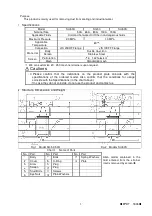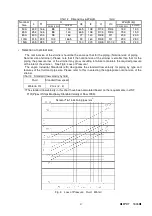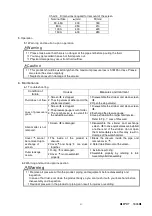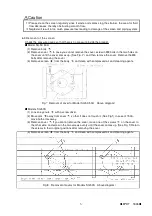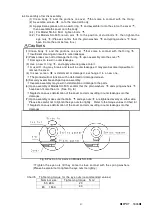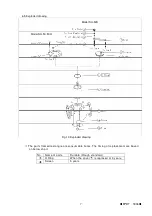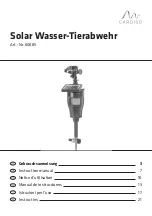
-4-
■
EPDT
-
183b
■
Chart 4 Dimensions required for removal of the screen
Nominal Size
A
(mm)
B
(mm)
50, 65A
300
180
80A
350
210
100A
400
220
150A
600
280
5. Operation
5.1 Warning and caution upon operation
Warning
(
1
)
Please make sure that there is no danger at the pipe end before pouring the fluid.
※
You may get scalded in case hot fluid spouts out.
※
Physical damage may occur from fluid outflow.
Caution
(
1
)
This product should be used only when the maximum pressure loss is 0.1MPa or less. Please
also clean the screen regularly.
※
Neglect can result in damage of the screen.
6. Maintenance
6.1 Troubleshooting
Condition of
failure
Causes
Measures and treatment
Fluid does not flow.
1. Screen
④
is clogged.
2. The stop valves at either end of the
strainer are closed.
1. Disassemble the strainer and clean screen
④
.
2. Open the stop valve(s).
Loss of pressure is
great.
1. Screen
④
is clogged.
2. The pressure gauge is out of order.
3. The nominal size is too small for
the actual flow volume.
1. Disassemble the strainer and clean screen
④
.
2. Exchange the pressure gauge.
3. Use a strainer with a larger nominal size,.
(
Refer to Fig.
3
: Loss of Pressure
)
Alien matter is not
removed.
1.Screen
④
is damaged.
1.Disassemble the strainer and exchange
screen
④
. In case quick valves are installed
at either end of the strainer, do not open
them immediately since this may result in
damage of the water hammer.
Cover
②
cannot
be removed upon
exchange of
screen.
1.The inside of the product is
vacuum.
2.Cover
②
and body
①
are stuck
together.
1.Break the vacuum inside the pipe and
remove cover
②
.
2. Refer to 6.3 Removal of the screen.
Outer leakage
occurs.
1.O-ring
⑧
is damaged.
2.Cover
②
is not assembled
properly.
1. Install a new O-ring.
2.Assemble properly by referring to 6.4
Assembly after disassembly.
6.2 Warning and caution upon inspection
Warning
(
1
)
Remove all pressure within the product, piping, and equipment before disassembly and
inspection.
In case of hot fluid, cool down the product body so you can touch it with your bare hand before
disassembly and inspection.
※
Residual pressure in the product or piping can result in injuries or scalding.


